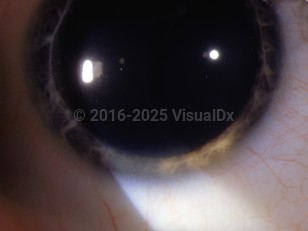Wilson disease
Alerts and Notices
Important News & Links
Synopsis

Wilson disease, also known as hepatolenticular degeneration, is a rare autosomal recessive inherited disorder caused by mutations in the ATP7B gene. It is characterized by copper accumulation in the tissues, particularly the brain, liver, kidneys, and corneas. The patient often presents in the first or second decade of life. Without treatment, Wilson disease will lead to liver failure, central nervous system (CNS) disorders (neurologic and psychotic), and eventually death. The majority of patients will present with either CNS (movement or speech) disorders or hepatic deficiency (ascites, anemia, etc). Corneal deposits are known as Kayser-Fleischer rings. The ring tends to begin in the superior cornea and slowly extends to become confluent inferiorly. The ring can be green to gold-brown in color. With proper treatment and management, the ring will slowly dissolve.
Codes
ICD10CM:
E83.01 – Wilson's disease
SNOMEDCT:
88518009 – Wilson's Disease
E83.01 – Wilson's disease
SNOMEDCT:
88518009 – Wilson's Disease
Look For
Subscription Required
Diagnostic Pearls
Subscription Required
Differential Diagnosis & Pitfalls

To perform a comparison, select diagnoses from the classic differential
Subscription Required
Best Tests
Subscription Required
Management Pearls
Subscription Required
Therapy
Subscription Required
References
Subscription Required
Last Reviewed:02/05/2017
Last Updated:01/25/2022
Last Updated:01/25/2022

